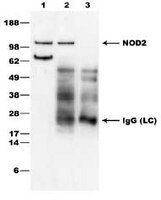ST1119 Sigma-AldrichAnti-NOD2/CARD15 Rabbit pAb
Recommended Products
Přehled
| Replacement Information |
|---|
Tabulka spec. kláve
| Host |
|---|
| Rb |
| References | |
|---|---|
| References | Fritz, J.H., et al. 2006. Nat. Immunol. 7, 1250. Radford-Smith, G. and Pandeya, N. 2006. World J. Gastroenterol. 12, 7097. |
| Product Information | |
|---|---|
| Form | Liquid |
| Formulation | In Tris-citrate/phosphate buffer, pH 7.0-8.0. |
| Preservative | ≤0.1% sodium azide |
| Physicochemical Information |
|---|
| Dimensions |
|---|
| Materials Information |
|---|
| Toxicological Information |
|---|
| Safety Information according to GHS |
|---|
| Safety Information |
|---|
| Product Usage Statements |
|---|
| Packaging Information |
|---|
| Transport Information |
|---|
| Supplemental Information |
|---|
| Specifications |
|---|
| Global Trade Item Number | |
|---|---|
| Katalogové číslo | GTIN |
| ST1119 | 0 |
Documentation
References
| Přehled odkazů |
|---|
| Fritz, J.H., et al. 2006. Nat. Immunol. 7, 1250. Radford-Smith, G. and Pandeya, N. 2006. World J. Gastroenterol. 12, 7097. |








